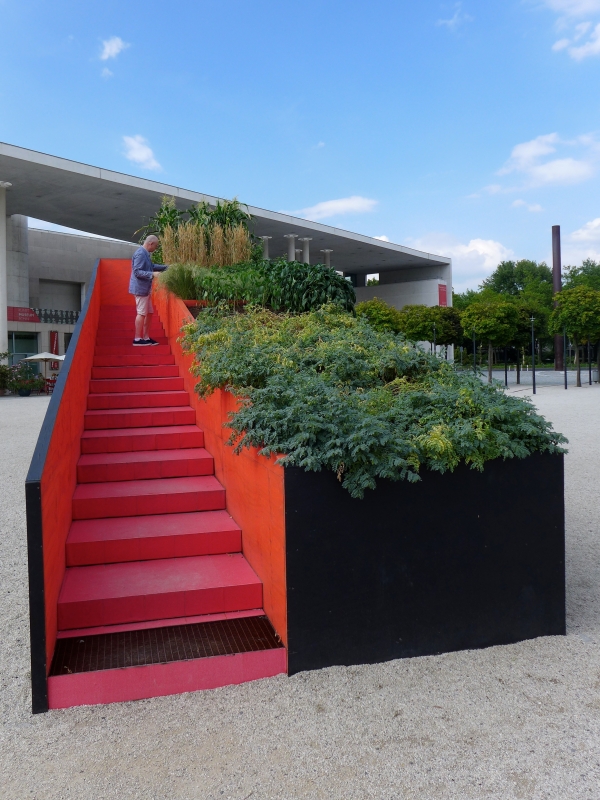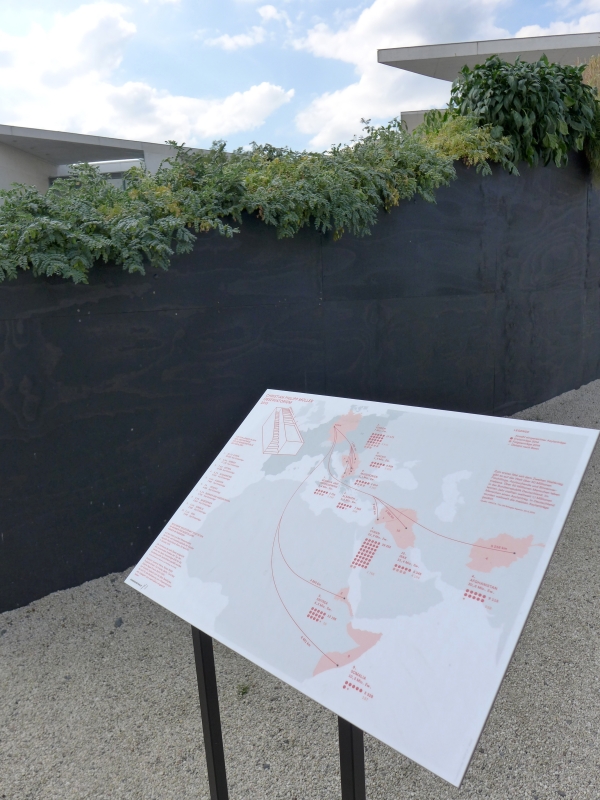Observatory
In: “Trouble in Paradise”
24 April – 11 October 2015
Kunst- und Austellungshalle der Bundesrepublik Deutschland (Art and Exhibition Hall of the State of Germany), Bonn
Installation:
Steel, plywood, soil, plants; 11.75 x 2.8 x 4 meters
Growing out of Müller's "Green Border" (1993) and "Hudson Valley Tastemakers" (2003) projects, "Observatory" is a visual play on a complex political issue that is currently being debated in German politics: the status of the numerous asylum seekers, migrants and refugees from Eastern Europe, Middle East and North Africa. With "Observatory," Müller provides a visual reference to the statistical breakdown of the number of refugees in Germany through a simple sculptural form that combines a staircase whose width and shape are paralleled by adjoining plant beds. Conceived for the exhibition "Trouble in Paradise" at the Bundeskunsthalle (National Art Gallery) in the historical capital of Bonn, the project brings to light issues of observation, semiotics, and utopianism through its Minimalist-inspired forms.
"Observatory," a site-specific work installed in the museum’s open plaza, references the top ten most represented nations among the 1.1 million applications for asylum in the Federal Republic of Germany in 2014 (in descending order): Syria, Serbia, Eritrea, Afghanistan, Albania, Kosovo, Bosnia and Herzegovina, Macedonia, Somalia and Iraq. Müller’s research on the statistical facts behind this phenomenon is reflected in the division of the plant beds into ten different sections, each size proportional to the percentage of applications made that year. Visitors to the exhibition may climb up the steps alongside the beds, each of which is filled with an edible plant species originating from its accompanying nation. In an accompanying map, Müller illustrates the facts underlying the status of refugees through a statistical analysis, while on the reverse he has included a botanical guide: an explanation of the significance of the crop with a traditional recipe from each locale. As in his projects "Köln–Düsseldorf" (1990) and "A Taste For Money" (2002), Müller has characteristically aestheticized the statistic.[1]
What once appears to be the presentation of pure facts becomes a poetic statement through its combination with the steps, which seemingly lead to nowhere, encouraging visitors to ask themselves about the nature of observation. Who, or what, exactly is observed in this piece? The project most obviously attests to the numbers of refugees in Germany, and thus reflects a contemporary social and political crisis. However, through the combination of the statistical breakdown of people, the corresponding map designed by Müller and the traditional recipes, the artist has humanized an act that has become all to dehumanizing and at times deadly.
Müller is imploring us to look beyond the words we read in the newspaper — for human beings are more than facts and figures — by making a parallel between the political act and natural world. The act of transporting seeds from their origin countries and planting them in beds designed to incubate seedlings before they find a permanent place to grow is designed as a counterpoint to the millions of refugees seeking a new home and perhaps a new identity abroad. The botanical transplantation mirrors the political situation of new refugees, who leave behind areas torn by war, hunger, and economic strife to begin a new life. At the same time, Müller intends for this act to be a social one: the plants are meant for consumption, both to nurture the body physically and to create a point of social interaction. The recipes that are included on the reverse of the map to the project can be prepared and shared by families and groups of friends (or even strangers), which, as with in his 2003 work "Hudson Valley Tastemakers," the artist hopes will catalyze conversations on the nature and politics inherent to Observatory.
The title and construction of "Observatory" refer simultaneously to the refugees and to astronomical observatories built in India during the 18th century to predict the movements of the sun, moon and planets. However, such celestial calculations cannot be made in relation to the migration patterns of refugees seen on the earth’s surface. Therefore, Müller’s form presents us with the utopian task of observing the unobservable. This quest is made all the more apparent when seen in the context of "Trouble in Paradise," the exhibition for which the work was conceived. Just as visitors reach a dead end at the top of Müller’s staircase, so too may refugees and migrants find their utopian dreams dashed upon their arrival in Germany.
Text by Cara Jordan
Notes
- For more on Müller’s aestheticization of statistical data see George Baker, “Lies, Damn Lies, and Statistics: The Art of Christian Philipp Müller,” Artforum, February 1997. Available: click here.


